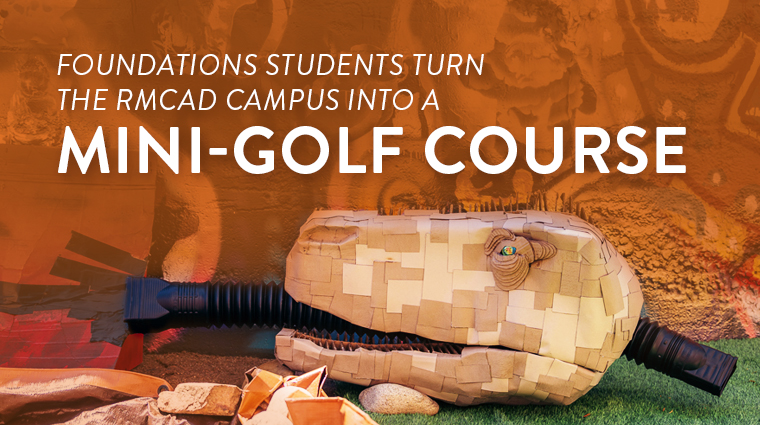
Foundations Professor Eric Mullis sets out each term to create fun and unique projects that challenge his 3D Design: Space + Materiality students. In the fall of 2023, Mullis was among the team that spearheaded the Playhouse project, where students constructed forts, clubhouses, and other art installations. Looking at the images of these clubhouses below, you would think that these are the works of RMCAD’s Fine Arts seniors. However, 3D Design: Space + Materiality is a graduation requirement for all students, most of whom are freshmen. “Many RMCAD students come into my class with 2D design skills, so 3D design can be a bit of a challenge,” says Mullis. However, challenges are what Mullis looks for in a good curriculum. Thus, in the spring of 2024, he raised the stakes by making students consider space and form. How did he up the ante? Two words: mini golf.
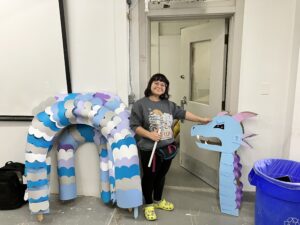
By having students design one-of-a-kind mini golf holes, they were tasked with considering the functional and aesthetic properties of 3D space. Mullis’ class was not designed to convert artists from 2D to 3D mediums, instead, he shared: “If you have a solid understanding of how form works in 3D space, that can make your 2D work more sophisticated.” The class’s first step was developing a theme to unify their work. This eccentric assignment sparked the class’s inspiration to exceed and subvert the expectations created by putt-putt holes of the past The class decided the theme would be monsters! Each team in the class had a unique take, ranging from monstrous greed embodied by a guillotine-shaped hole to a Leviathan sea monster guardian its hole.
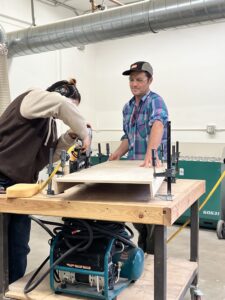
Two students in particular had a ball with the class’s theme when building their hole, “Volcanic Vengeance.” Cole Shamberg (Fine Arts) and Emily Vialpando (2D Animation) had an ambitious vision to bring to the green. Their mini golf hole, which they estimate as a par 16, was an homage to kaiju films like ‘Godzilla.’ Players had to navigate their ball through a miniature city, past a ravenous dragon, around a constructed water feature, and into a volcano-shaped hole. However, designing the hole was not without its bumps in the road. The concrete ramp, which Shamberg and Vialpando had built their hole on, caused balls to “ping-pong” around making it nearly impossible to play. Luckily, Shamberg is an avid golfer and Vialpando had worked groundskeeping for a golf course, so both knew it was just a matter of manicuring the rock-hard surface.
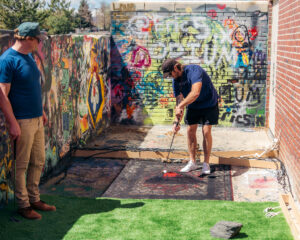
Using an old rug, the team softened the fairway to prevent the ball from bouncing around. This discovery led to a quantum leap in the design of the hole. The foundations students began padding the course with a wide array of other materials, such as cardboard and sand. Not only did Shamberg and Vialpando consider form and space, but they also made a great game! Vialpando shared that her biggest takeaway from the class was that, “anytime I’m making something sculptural, even for animation. It helps to get that physical, real-world sense of the shape and space.” These skills have already been put to use beyond the classroom by Shamberg. One of his pieces from Mullis’ class was selected to be displayed by the 40 West Arts District.
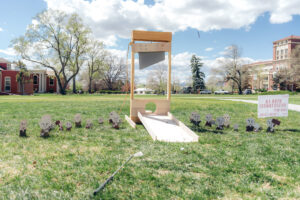
In the end, the 3D Design: Space + Materiality students designed nine unique mini-golf holes. As any experienced putt-putter will tell you, each hole comes with a new set of challenges that require technique and creativity, and Mullis’ students will tell you the same thing. Professor Mullis shares that his class is all about taking creative challenges head-on and learning how to use them to advance one’s art. He believes, “The creative process is difficult. You always hit this crisis point in a project. If you can learn to recognize and accept that, then you can see it as part of the greater process, where things start to come together.”
Looking to Tee Up Your Education?
If you are a creative thinker looking for a new challenge, then look no further than Rocky Mountain College of Art + Design! With accredited bachelor’s degrees ranging from Fine Arts to Game Art to Music Production, RMCAD is where creative careers begin. Learn more now about learning on-campus and online.
Many of the quotes in this story have been edited for brevity and clarity by the author, but retain the significance and purpose of the original speaker.
